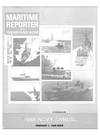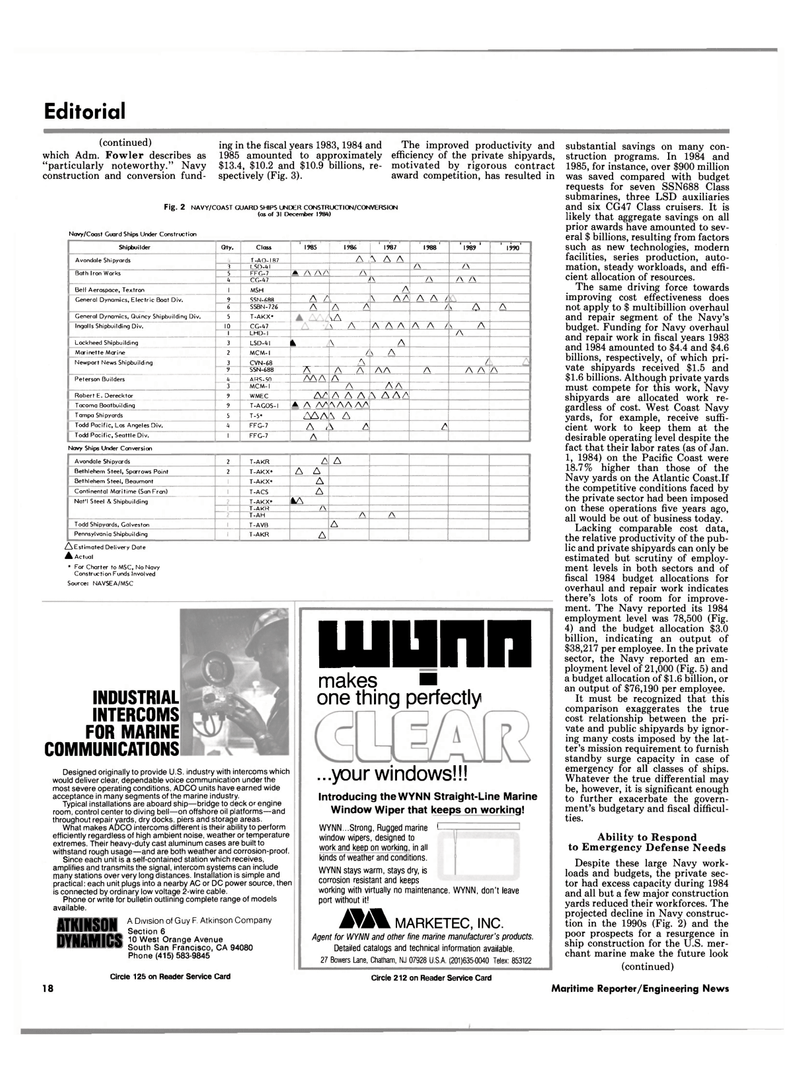
Page 16: of Maritime Reporter Magazine (February 1986)
Read this page in Pdf, Flash or Html5 edition of February 1986 Maritime Reporter Magazine
Editorial (continued) which Adm. Fowler describes as "particularly noteworthy." Navy construction and conversion fund- ing in the fiscal years 1983,1984 and 1985 amounted to approximately $13.4, $10.2 and $10.9 billions, re- spectively (Fig. 3).
The improved productivity and efficiency of the private shipyards, motivated by rigorous contract award competition, has resulted in
Fig. 2 NAVY/COAST GUARD SHIPS UNDER CONSTRUCTION/CONVERSION (as of 31 December 1984)
Navy/Coast Guard Ships Under Construction
Shipbuilder Qty. Class —1 1 1— 1985 1 i 986 —i—i—1— 1987 —i—i—i— 1988 —r-i—I— 1989 1 • T 1990
Avondale Shipyards T-AO-187 A ^ A A 3 LSD-41 A A
Bath Iron Works 5 FFG-7 • A A/\ A it
CG-47 A A A A
Bell Aerospace, Textron 1 MSH A
General Dynamics, Electric Boat Div. 9 SSN-688 A r \ AA A A / 6 SS8N-726 A A A / * A A
General Dynamics, Quincy Shipbuilding Div. 5 T-AKX* ^A
Ingalls Shipbuilding Div. 10 CC-U1 * A AAA A A / X A 1 LHD-I A
Lockheed Shipbuilding 3 LSD-41 k \ A
Marinette Marine 2 MCM-I L \ A
Newport News Shipbuilding 3 CVN-68 A zz 9 SSN-688 A A A AA A A A A
Peterson Builders b ARS-50 MA A 3 MCM-I A AA
Robert F. Derecktor 9 WMEC A£ A A A ^ ^ AAA
Tacoma Boatbuilding 9 T-AGOS-I A A AA "\AAAA,
Tampa Shipyards 5 T-5* AAA ^ A
Todd Pacific, Los Angeles Div. k FFG-7 A i ^ A £
Todd Pacific, Seattle Div. 1 FFG-7 A
Navy Ships Under Conversion
Avondale Shipyards 2 T-AKR A A
Bethlehem Steel, Sparrows Point 2 T-AKX* A A
Bethlehem Steel, Beaumont 1 T-AKX* A
Continental Maritime (San Fran) 1 T-ACS A
Nat'l Steel & Shipbuilding T-AKX- &A 1 T-AKR A
T-AH A A
Todd Shipyards, Galveston I T-AVB A
Pennsylvania Shipbuilding 1 T-AKR A
A Estimated Delivery Date
A Actual * For Charter to MSC, No Navy
Construction Funds Involved
Source: NAVSEA/MSC
INDUSTRIAL
INTERCOMS
FOR MARINE
COMMUNICATIONS
Designed originally to provide U.S. industry with intercoms which would deliver clear, dependable voice communication under the most severe operating conditions, ADCO units have earned wide acceptance in many segments of the marine industry.
Typical installations are aboard ship—bridge to deck or engine room, control center to diving bell—on offshore oil platforms—and throughout repair yards, dry docks, piers and storage areas.
What makes ADCO intercoms different is their ability to perform efficiently regardless of high ambient noise, weather or temperature extremes. Their heavy-duty cast aluminum cases are built to withstand rough usage—and are both weather and corrosion-proof.
Since each unit is a self-contained station which receives, amplifies and transmits the signal, intercom systems can include many stations over very long distances. Installation is simple and practical: each unit plugs into a nearby AC or DC power source, then is connected by ordinary low voltage 2-wire cable.
Phone or write for bulletin outlining complete range of models available.
ATKINSON
DYNAMICS
A Division of Guy F. Atkinson Company
Section 6 10 West Orange Avenue
South San Francisco, CA 94080
Phone (415) 583-9845
IMINVI makes • one thing perfectly ...your windows!!!
Introducing theWYNN Straight-Line Marine
Window Wiper that keeps on working!
WYNN...Strong, Rugged marine L window wipers, designed to work and keep on working, in all kinds of weather and conditions.
WYNN stays warm, stays dry, is corrosion resistant and keeps working with virtually no maintenance. WYNN, don't leave port without it!
M MARKETEC, INC.
Agent for WYNN and other fine marine manufacturer's products.
Detailed catalogs and technical information available. 27 Bowers Lane, Chatham, NJ 07928 U.S.A. (201)635 0040 Telex: 853122
Circle 125 on Reader Service Card substantial savings on many con- struction programs. In 1984 and 1985, for instance, over $900 million was saved compared with budget requests for seven SSN688 Class submarines, three LSD auxiliaries and six CG47 Class cruisers. It is likely that aggregate savings on all prior awards have amounted to sev- eral $ billions, resulting from factors such as new technologies, modern facilities, series production, auto- mation, steady workloads, and effi- cient allocation of resources.
The same driving force towards improving cost effectiveness does not apply to $ multibillion overhaul and repair segment of the Navy's budget. Funding for Navy overhaul and repair work in fiscal years 1983 and 1984 amounted to $4.4 and $4.6 billions, respectively, of which pri- vate shipyards received $1.5 and $1.6 billions. Although private yards must compete for this work, Navy shipyards are allocated work re- gardless of cost. West Coast Navy yards, for example, receive suffi- cient work to keep them at the desirable operating level despite the fact that their labor rates (as of Jan. 1, 1984) on the Pacific Coast were 18.7% higher than those of the
Navy yards on the Atlantic Coast.If the competitive conditions faced by the private sector had been imposed on these operations five years ago, all would be out of business today.
Lacking comparable cost data, the relative productivity of the pub- lic and private shipyards can only be estimated but scrutiny of employ- ment levels in both sectors and of fiscal 1984 budget allocations for overhaul and repair work indicates there's lots of room for improve- ment. The Navy reported its 1984 employment level was 78,500 (Fig. 4) and the budget allocation $3.0 billion, indicating an output of $38,217 per employee. In the private sector, the Navy reported an em- ployment level of 21,000 (Fig. 5) and a budget allocation of $1.6 billion, or an output of $76,190 per employee.
It must be recognized that this comparison exaggerates the true cost relationship between the pri- vate and public shipyards by ignor- ing many costs imposed by the lat- ter's mission requirement to furnish standby surge capacity in case of emergency for all classes of ships.
Whatever the true differential may be, however, it is significant enough to further exacerbate the govern- ment's budgetary and fiscal difficul- ties.
Ability to Respond to Emergency Defense Needs
Despite these large Navy work- loads and budgets, the private sec- tor had excess capacity during 1984 and all but a few major construction yards reduced their workforces. The projected decline in Navy construc- tion in the 1990s (Fig. 2) and the poor prospects for a resurgence in ship construction for the U.S. mer- chant marine make the future look (continued)
Circle 212 on Reader Service Card 18 Maritime Reporter/Engineering News

 15
15

 17
17
